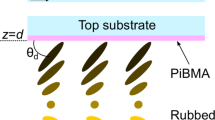Abstract
Two possible mechanisms of the temperature-induced variation and jump of the helix pitch in a spatially bounded planar layer of a cholesteric liquid crystal (LC) was considered within the framework of the continuum theory of elasticity. These mechanisms are related to the existence of two configuration curves of the system free energy. The states with local free energy minima on each of the configuration curves correspond to topologically equivalent configurations of the LC director distribution and are quasi-equivalent in this sense. The transitions between such quasi-equivalent states are especially important in the first mechanism of the helix pitch jump proceeding without participation of defects. The second mechanism is related to transitions between the ground states of different configuration curves corresponding to topologically nonequivalent configurations. This mechanism requires either participation of disclination lines or the formation of defects.
Similar content being viewed by others
References
G. S. Chilaya, Kristallografiya 45, 944 (2000) [Crystallogr. Rep. 45, 871 (2000)].
V. A. Belyakov and E. I. Kats, Zh. Éksp. Teor. Fiz. 118, 560 (2000) [JETP 91, 488 (2000)].
H. Zink and V. A. Belyakov, Mol. Cryst. Liq. Cryst. 265, 445 (1995).
H. Zink and V. A. Belyakov, Mol. Cryst. Liq. Cryst. 329, 457 (1999).
L. M. Blinov and V. G. Chigrinov, Electrooptic Effects in Liquid Crystal Materials (Springer-Verlag, New York, 1994).
J. D. Bunning, T. E. Faber, and P. L. Sherrell, J. Phys. (Paris) 42, 1175 (1981).
D. W. Berreman and W. R. Heffner, J. Appl. Phys. 52, 3032 (1981).
P. J. Bos, P. Watson, J. E. Anderson, et al., in Proceedings of International Display Research Conference “Eurodisplay’99”, Berlin, 1999, p. 397.
G. Barbero, N. V. Madhusudana, and G. Durand, Z. Naturforsch. A 39, 1066 (1984).
S. P. Palto, Zh. Éksp. Teor. Fiz. 119, 638 (2001) [JETP 92, 552 (2001)].
Author information
Authors and Affiliations
Additional information
__________
Translated from Zhurnal Éksperimental’no\(\overset{\lower0.5em\hbox{$\smash{\scriptscriptstyle\smile}$}}{l}\) i Teoretichesko\(\overset{\lower0.5em\hbox{$\smash{\scriptscriptstyle\smile}$}}{l}\) Fiziki, Vol. 121, No. 2, 2002, pp. 308–319.
Original Russian Text Copyright © 2002 by Palto.
Rights and permissions
About this article
Cite this article
Palto, S.P. On mechanisms of the helix pitch variation in a thin cholesteric layer confined between two surfaces. J. Exp. Theor. Phys. 94, 260–269 (2002). https://doi.org/10.1134/1.1458475
Received:
Issue Date:
DOI: https://doi.org/10.1134/1.1458475




